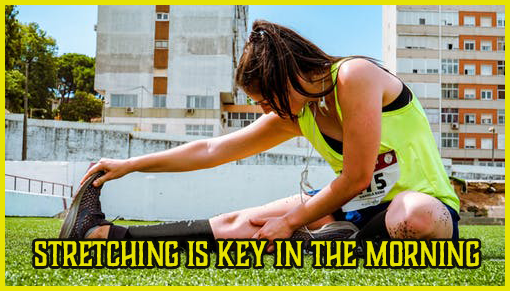There’s something magical about exercise in the morning. But you will bring a few risks with you, which you should know about, and avoid. Early in the morning, the city is still sleeping. But there is already a lot going on in the running track and in the gym.
I am a self-confessed night owl and morning muffle. But I LOVE morning sports. With a few tricks, we “owls” get going well in the morning. And the feeling afterward is simply great.
But also the larches among us, who are wide awake without an alarm clock at 5 o’clock, should know: An intensive endurance or strength training shortly after getting up is NEVER ideal. It would be ideal if we gave our body a few hours to get up to temperature.
But most of us do a job and have other commitments late in the morning than a workout session. And that’s okay! You can still train in the morning AND expect great progress. As long as you keep a few things in mind.
Especially when it comes to exercise in the morning and early morning sports, there’s more at stake than usual:
- Injury or overload of the intervertebral discs and joints.
2. Lack of strength and therefore no training stimulus – the training becomes ineffective.
3. Breakfast or not? With a full stomach, you lack the power to give everything in training – with an empty stomach maybe?
The good news: All this can be solved and you can eliminate all risks.
Here are three simple, tried and tested strategies for optimal exercise in the morning.
What makes morning training so special?
Why you should train in the morning (and what you risk)

Why I love to go training in the morning – and why you should try it:
- You start the day full of energy.
- Your body feels incredibly good all day long.
- You don’t have to get up after a long day at work.
- The last job meeting is dragging on, the barbecue is calling out, where is there still time for training? Anyone who has been training in the morning can lean back and relax.
- The gyms are overcrowded in the evening and empty in the morning.
If, like me, you’re a night owl, you’ll find 7 simple tricks for learning to love early morning sports here.
If you want to run slowly, you can’t do much wrong. Getting up, running away. As long as you can train with your eyes open, the risk of injury is kept to a minimum.
If you’re planning a hard workout (interval runs? Severe knee bends or crucifix lifts?), you should know a few things:
- When you get up in the morning, your entire musculoskeletal system is often still stiff and immobile.
- The synovial fluid has settled due to lying down for several hours and does not lubricate your intervertebral discs and joints sufficiently.
- When you sleep, your body temperature drops: muscles, tendons and joints are less well supplied with blood and cannot yet fully develop their performance potential – like a cold engine.
- What happens if you run a cold engine at full load? If you’re lucky, nothing. Except it doesn’t deliver full power. If you are unlucky, you will damage it permanently.
- So you bring your body quickly to operating temperature and avoid injuries.
Exercise in the morning: How to NOT fail in the process
The ultimate success strategy for your morning sport consists of three simple phases:
Phase I: – From “deep sleep” to “wide awake” in 60 minutes
Phase II: DABEI – Training in the morning means training smart
Phase III: DANACH – Nutrition makes the difference
The alarm’s ringing. I woke up. Here we go.
I. – From “deep sleep” to “wide awake” in 60 minutes
Just as a Formula 1 pilot prepares and warms his racing car before the competition, you can take care of your body. Fortunately, you can bring your “engine” up to operating temperature in 60 minutes in just three simple steps.
1. Early to bed, early to rise
When the alarm clock rings in the morning and you only have four and a half hours of sleep on the speedometer, getting up can be harder than your workout. Training with a sleep deficit is at best half-hearted, training results are mediocre.
The key lies in your bedtime habits. You can change that. Best not overnight, but in these 7 simple steps.
It’s easier than you think!
2. Hot showers
In the morning trainers, hot showers. We assume you start your training at 7 o’clock. At 6 am you get up, brush your teeth and jump under the hot shower for a few minutes.
“A hot shower BEFORE training? Mark, then I’ll shower twice!”
Exactly.
The hot shower before training is your bonus warmup:
The warmth stimulates your circulation and loosens joints, tendons, fasciae, and muscles – and prepares them for your training.
A few minutes won’t dry out your skin. Especially if you only use water – you can save the soap for afterward.
Try it out! With a hot shower beforehand you will train more safely and effectively.
3. breakfast or not breakfast, that is the question here!

Muscle building happens in the kitchen. 60 minutes are very scarce if you also want to have breakfast in it.
Training with a full stomach? This isn’t good for exercise in the morning. It can hinder your ability to do certain exercises.
If you have replenished your glycogen stores the day before with carbohydrates, you can also get going without breakfast. If you are looking for fat reduction or fat metabolism training, training in the “Fasted State” is the most effective anyway.
However, you should not leave the house on a completely empty stomach. Instead, more and more people are staying on …
The Magic Minimalist Breakfast (MMF):
- 1 cup of black tea, coffee or 1 double espresso.
- 10 g BCAAs
The caffeine gets your circulation going, increases fat metabolism, and is great for assisting your exercise in the morning. The BCAAs (I use them) stimulates the protein synthesis in the muscle and avoid muscle breakdown without straining the digestion. The 60 minutes are almost over, you are awake and on your way to your workout. You can press the accelerator pedal right away. Not without sense and understanding, but with brains.
II. Training in the morning means smart training.
Endurance training. Ready to go. Ready, steady … go?
Not yet!
Training in the morning means training smart and above all playing it safe:
- Extra-long warm-up: Take 3-5 minutes for the general warm-up – to jump on the rope, on the cardio machine or to warm up if you are training outside. Then you go over to the specific warm-up, i.e. you prepare your muscles again 5 minutes with functional exercises for the coming load.
- Start with light exercises: If you are prone to injuries, squats or crucifix lifts and you also want to train in the morning, start with easier routines before you start the queen of exercises. Before you go to the limit with barbell knee bends or cross lifting, you can, for example, add 3 sets of (one-leg) knee bends with bodyweight, leg curls on the machine or Swissball leg curls. Of course, your muscles will then be pre-tired and you will not be able to carry as much weight in the actual king’s set as if you had rested on it. But the weight is relative – what counts is the training stimulus. In this way, you set it with a significantly lower risk of injury. And you will notice how you become stronger.
- The training is finished. And when you get out of the shower you feel like a newborn. Before you start to further heroic deeds, you should give your body what it needs for a good regeneration.
Nutrition makes the difference
Superfood supplement powder. The perfect post-workout meal – as always – depends on your goals. If you want to regenerate quickly, build muscle and become stronger, you should now eat a healthy combination of proteins and carbohydrates. For example, a protein-fruit shake or protein powder with sweet fruit. Baby food with sweet potatoes is a good carbohydrate source on the go.
If fat loss is your number one priority, you can skip carbohydrates after exercise and limit yourself to protein. A protein shake with water, e.g. with a long-satiating casein protein, is quite simple for on the go.
Conclusion

If you want to train in the morning, use these simple tricks to get the most out of it and avoid injuries.
Here once again your 8 action items at a glance:
- Go to bed on time.
- Get up 60 minutes before the workout.
- Take a hot shower.
- Drink hot coffee /tea/espresso.
- Take 10 g BCAAs (breakfast not required).
- Warm extensively. –
- Start with lighter exercises + slowly “start-up”
- Protein as a post-workout meal, if necessary with carbohydrates – III.
If our post here about exercise in the morning has helped you, consider our diets section for more help on nutrition!

